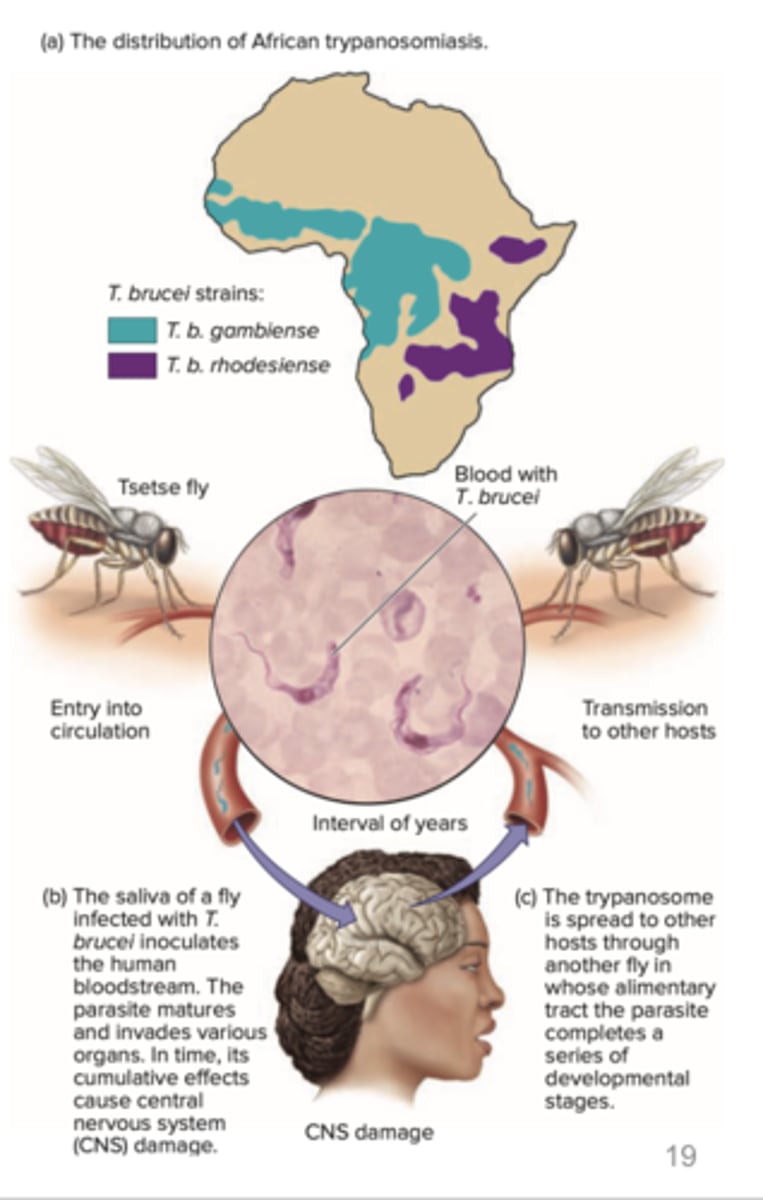Unit 15. Infectious Diseases Affecting the Nervous System
1/63
There's no tags or description
Looks like no tags are added yet.
Name | Mastery | Learn | Test | Matching | Spaced |
|---|
No study sessions yet.
64 Terms
Central nervous system (CNS):
brain and spinal cord
Peripheral nervous system (PNS)
nerves that emanate from the brain and spinal cord to sense organs and the periphery of the body
CNS:
Dense organs made of neurons Surrounded by membranes: the meninges
Cerebrospinal fluid (CSF)
provides nutrients and protection
anatomy of nervous system image

Defenses and normal biota of the nervous system chart

Link between the gut microbiome and the nervous system:
the gut-brain axis
Viruses (like herpes simplex) in a dormant state not considered
normal biota
Meningitis
Inflammation of the meninges, an excellent example of an anatomical syndrome. Most often infectious, most severe forms caused by bacteria
Signs and symptoms of Meningitis
photophobia, headache, painful or stiff neck, fever, and an increased number of white blood cells in the CSF
• Diagnostic involves gram stain and/or culture of bacteria in the CSF
• May be acute or chronic
Meningitis caused by
Neisseria meningitidis
Meningococcal meningitis
Most serious form of acute meningitis
• Portal of entry at the nasopharynx
• Symptoms and signs: high fever, sore throat,headache, stiff neck, convulsions, and vomiting.
• Complication: meningococcemia; bacterial endotoxin stimulates cytokine production by WBCs.Damage to blood vessels provokes petechiae.Fever higher than 40ºC, chills, delirium, severe widespread ecchymosis (areas of bleeding under the skin), shock, and coma. May be fatal Transmission electron micrograph of Neisseria (52,000X)
Meningitis graph
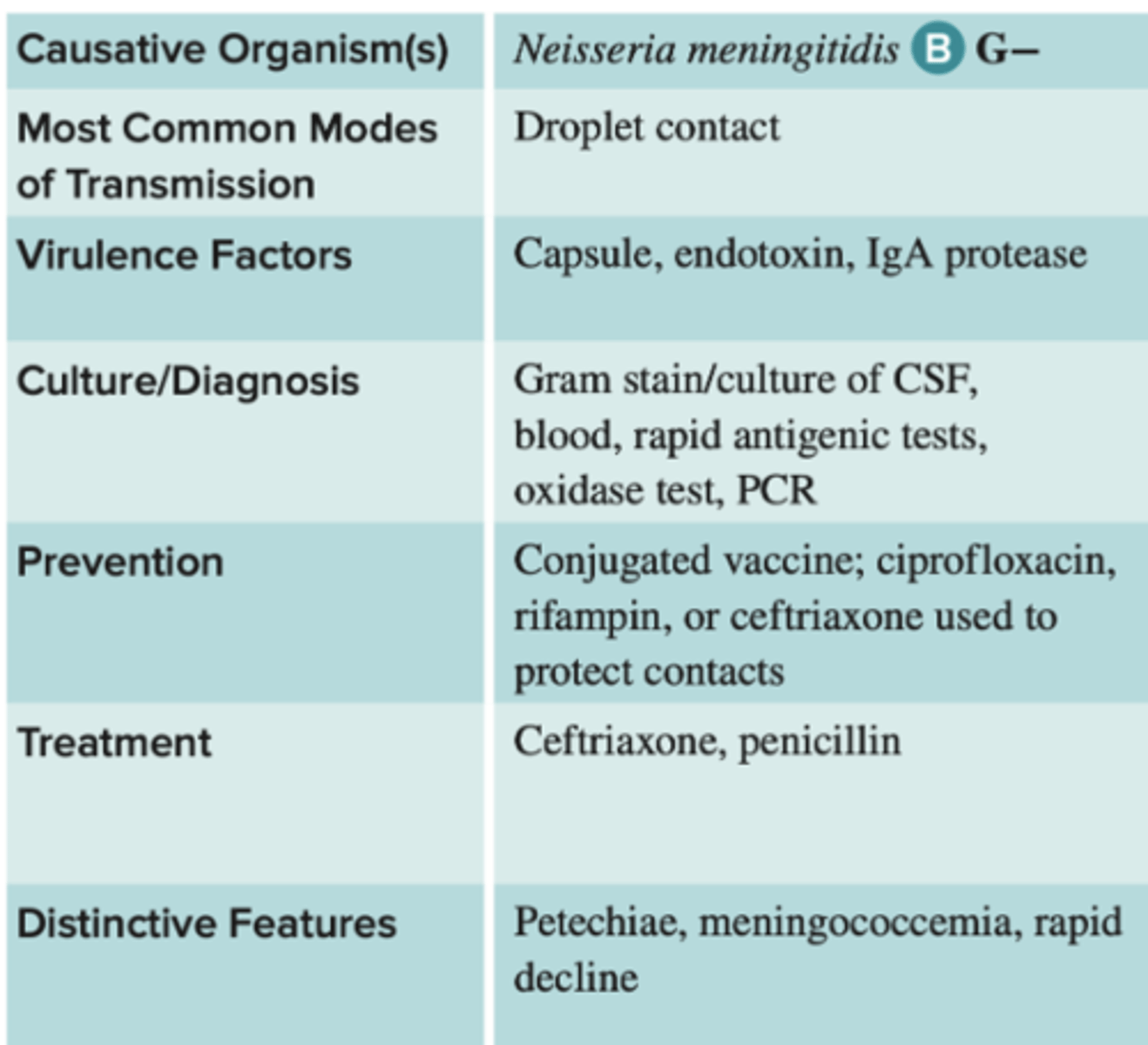
Streptococcus pneumoniae
(pneumococcal meningitis):
•Most common cause of meningitis
•Less severe. No petechiae
•Often associated with pneumonia.
•Produces hemolysin and H2O2 to damage tissue. Also induces apoptosis
Haemophilus influenzae
•Severe meningitis.
•Incidence diminished after vaccination
Listeria monocytogenes
(listeriosis)
•Most often, a mild or subclinical disease.
•Affects brain and meninges. May provoke septicemia.
•Entry most often byingestion
Other bacterial meningitis graph
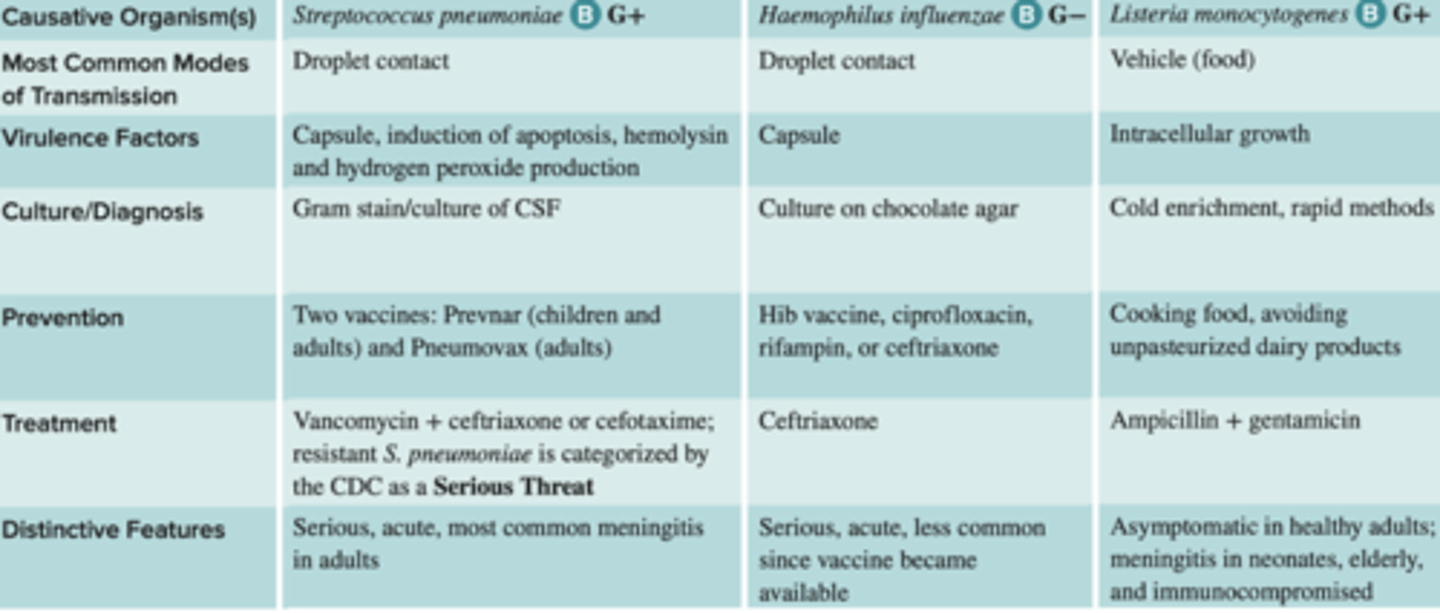
Fungal meningitis
Cryptococcus neoformans, Coccidioides immitis
Cryptococcus neoformans
• Gradual onset of symptoms (chronic)
• Unicellular fungus (yeast) with great capsule.
• Transmitted by birds via respiratory tract
• May turn systemic and affect other organs (skin, bones)
Coccidioides immitis
Systemic, highly virulent infection
Fungal meningitis graph
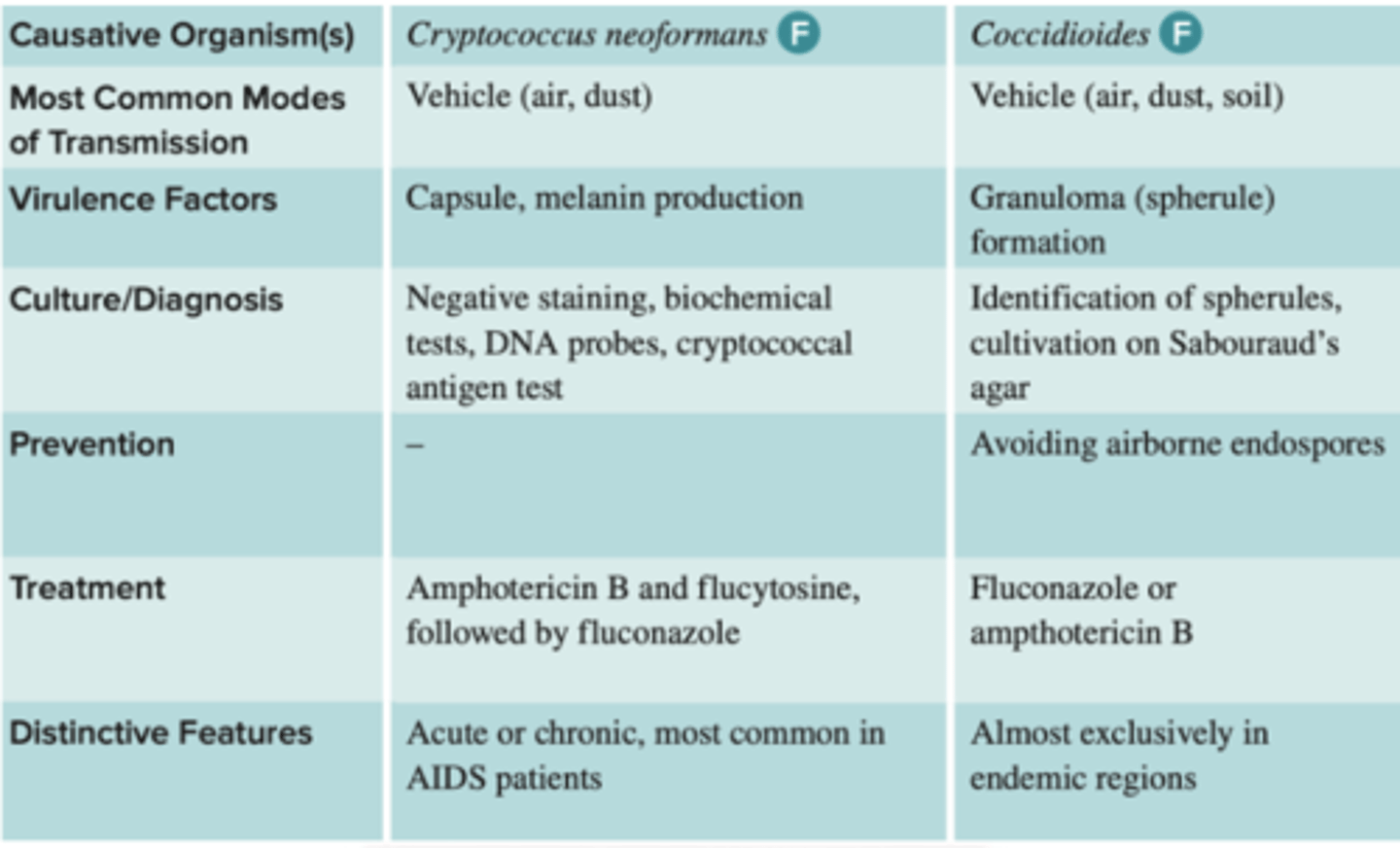
Viral meningitis
• Caused by enteroviruses or herpesviruses
• Most common cause of meningitis
• Milder than bacterial or fungal meningitis
Viral meningitis graph
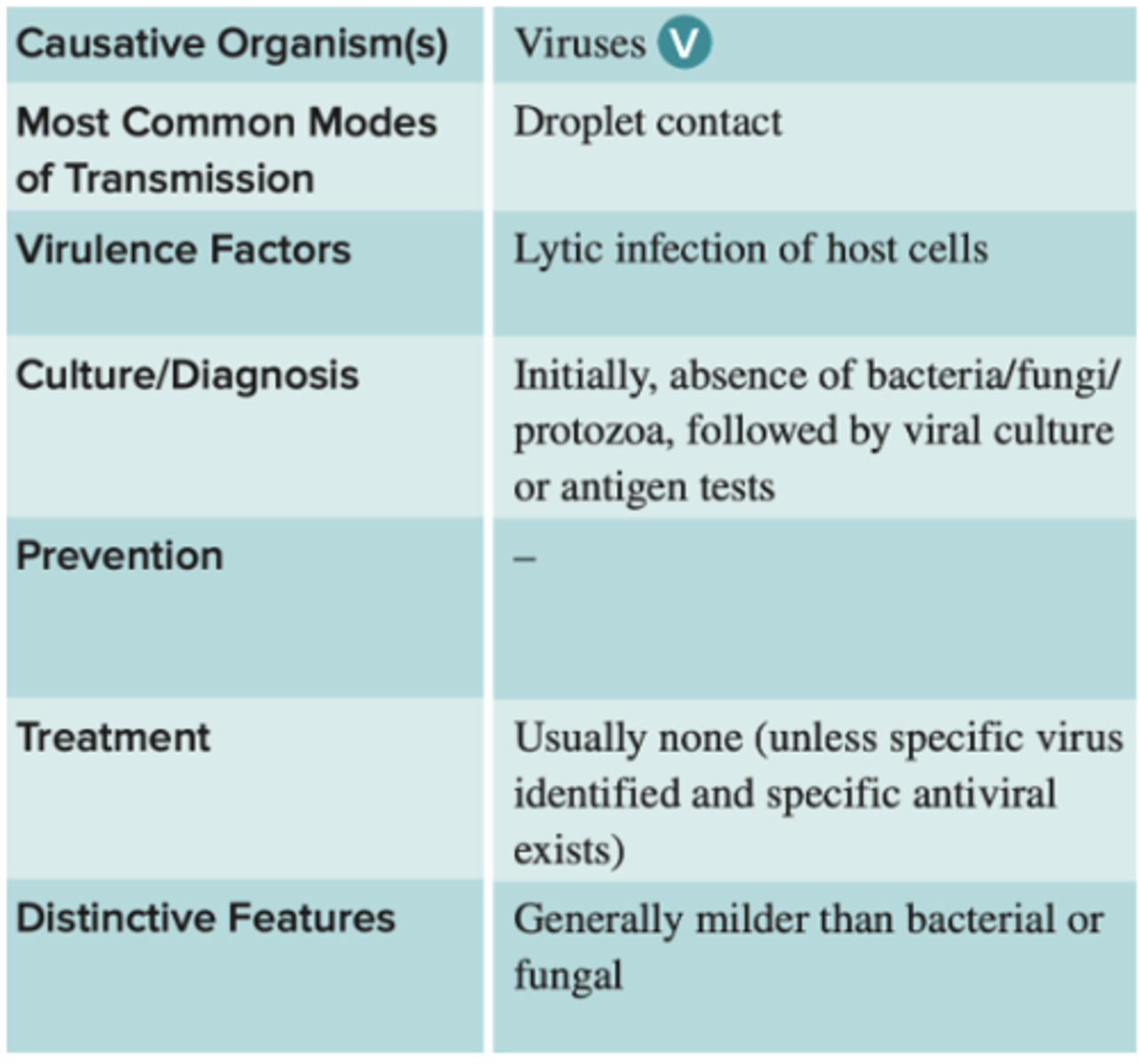
Neonatal and Infant meningitis
• Bacterial meningitis, transmitted vertically during birth. Also in baby formula
Neonatal and Infant meningitis graph
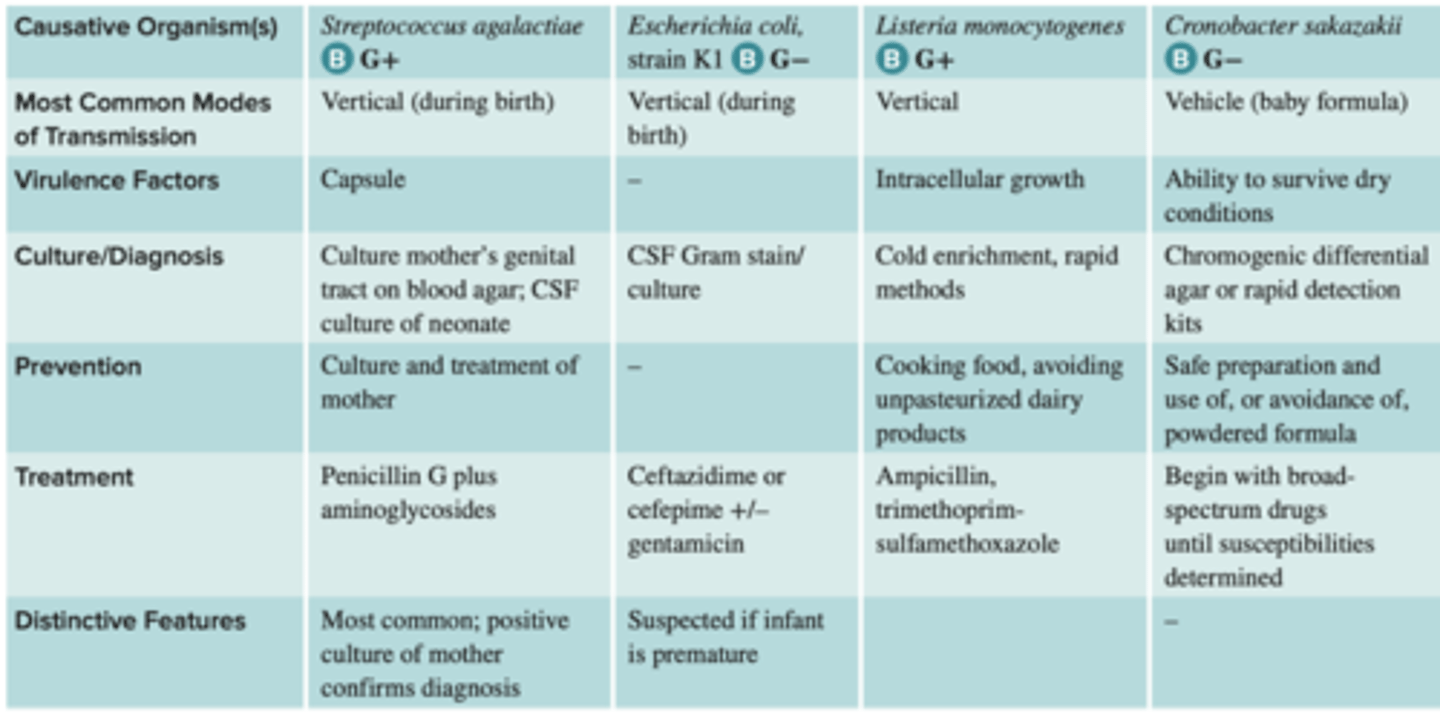
Meningoencephalitis
Infections affecting the meninges and brain.
two types:
Naegleria fowleri
Acanthamoeba
Naegleria fowleri
•A protozoan (amoeba). Transmitted through thenasal mucosa.
•Primary amoebic meningoencephalitis (PAM): rapid destruction of brain and spinal tissue -> hemorrhage and coma -> death within a week
Acanthamoeba:
•Similar to Naegleria; Portal of entry, skin and eye injuries. Slower course of disease.
•Granulomatous amoebic meningoencephalitis(GAM)
Meningoencephalitis graph
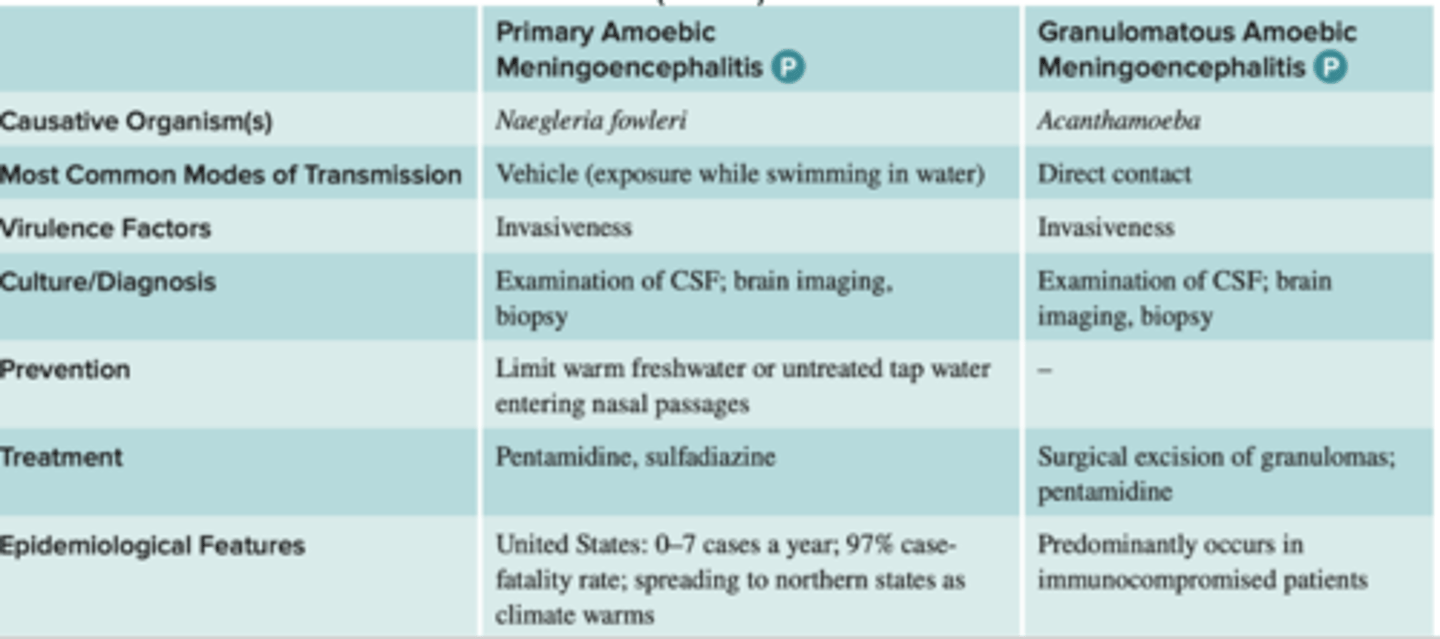
Acute encephalitis
• Encephalitis is a serious condition involving an inflammatory process in the brain
• Acute forms: viral diseases caused by a variety of viruses
• Symptoms and signs: those of meningitis plus behavior changes or confusion because of inflammation. Decreased consciousness and seizures frequent.
• Some may be treated with antivirals (acyclovir, zydovudine, etc.)
acute encephalitis graph
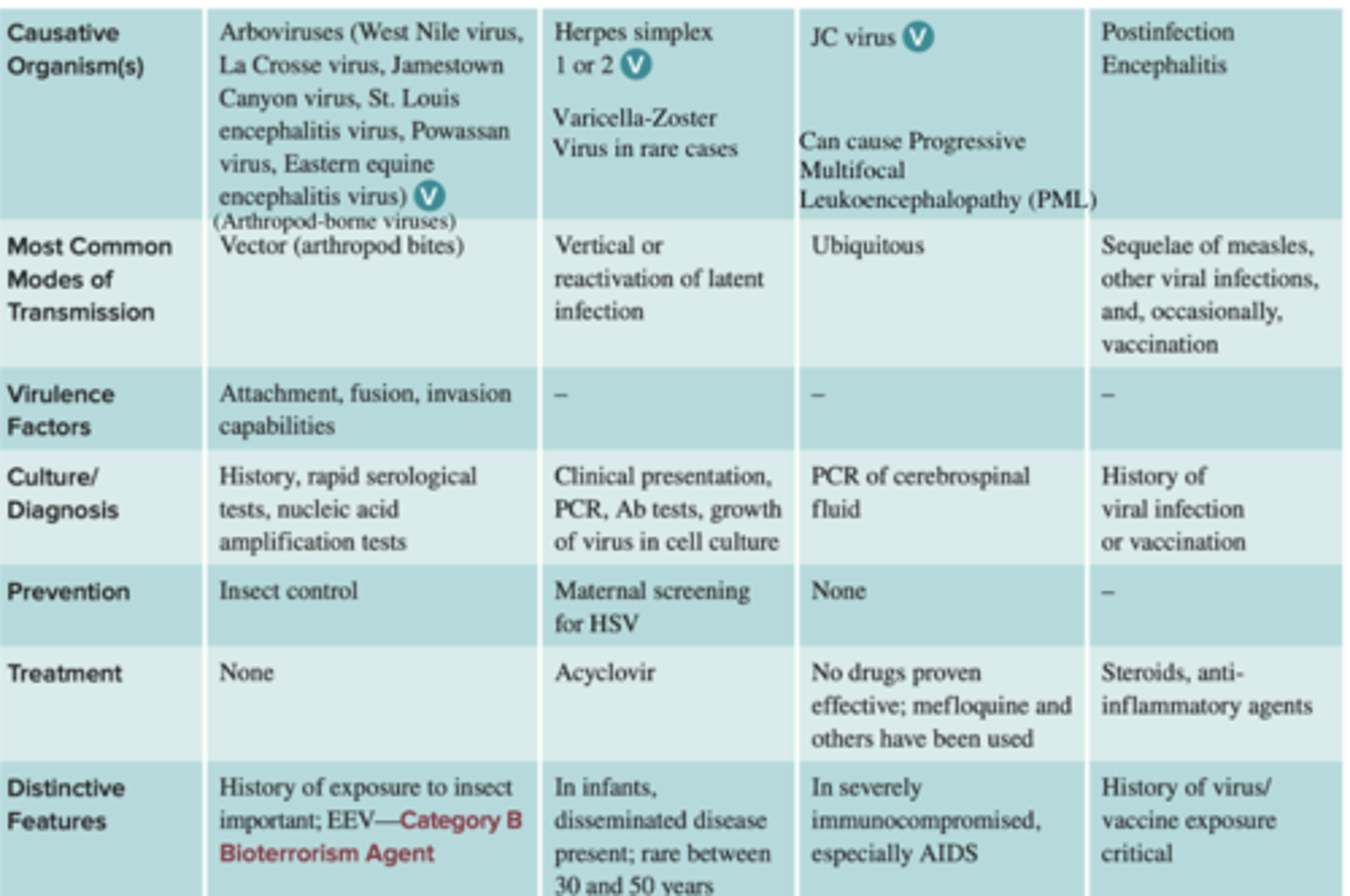
Subacute encephalitis: toxoplasmosis
• Most common form of subacute encephalitis
• Caused by protozoan parasite Toxoplasma gondii
Subacute encephalitis toxoplasmosis signs and symptoms
Most cases asymptomatic or benign. Immunosuppressed patients often show extensive brain lesions and fatal disruptions of the heart and lung. Congenital infection associated with stillbirth and severe organ abnormalities
• Fecal-oral transmission.
Reservoir in wild and domestic felines. Also acquired by eating contaminated food
*Widely spread, most people infected
Subacute encephalitis: toxoplasmosis graph

Subacute encephalitis: toxoplasmosis image chain
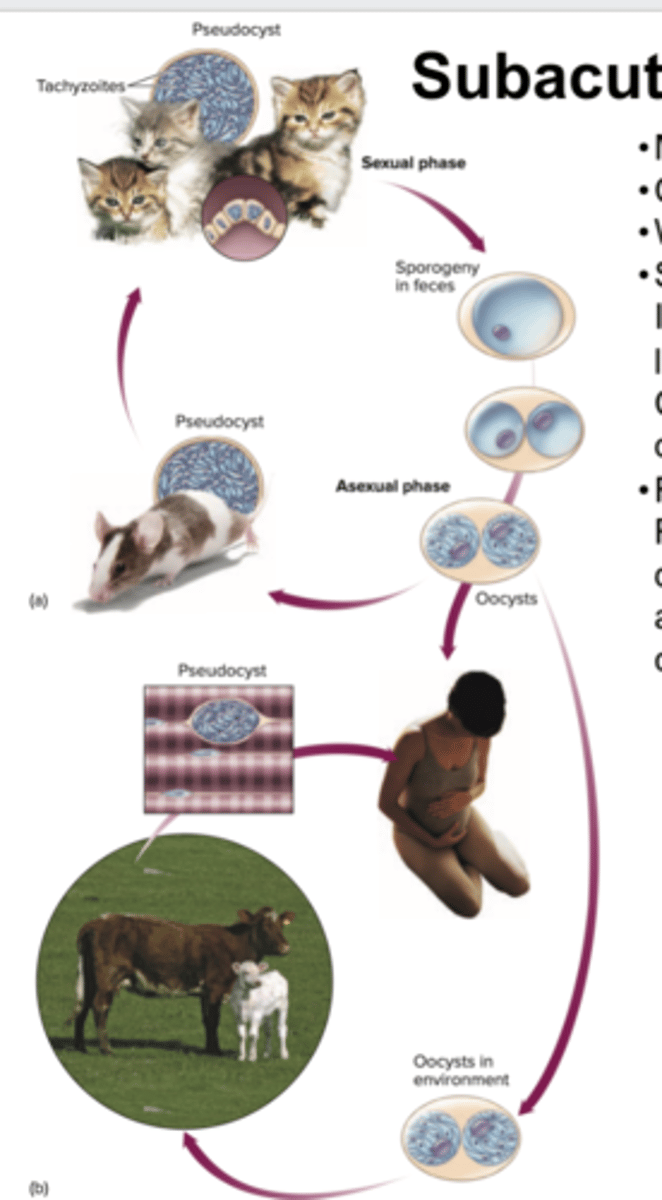
Other forms of subacute encephalitis
Subacute sclerosing panencephalitis (SSPE), Creutzfeldt-Jakob disease (CJD)
Subacute sclerosing panencephalitis( SSPE)
Caused by reactivated measles virus
Creutzfeldt-Jakob disease (CJD)
• Caused by prions: proteinaceous infectious particles containing no genetic material
• Human form of transmissible spongiform encephalopaties (TSEs), neurodegenerative diseases with long incubation periods but rapid progressions
• Symptoms of CJD include altered behavior,dementia, memory loss, impaired senses,delirium, and premature senility. Death usually occurs within 1 year of diagnosis
SSPE and CJD chart
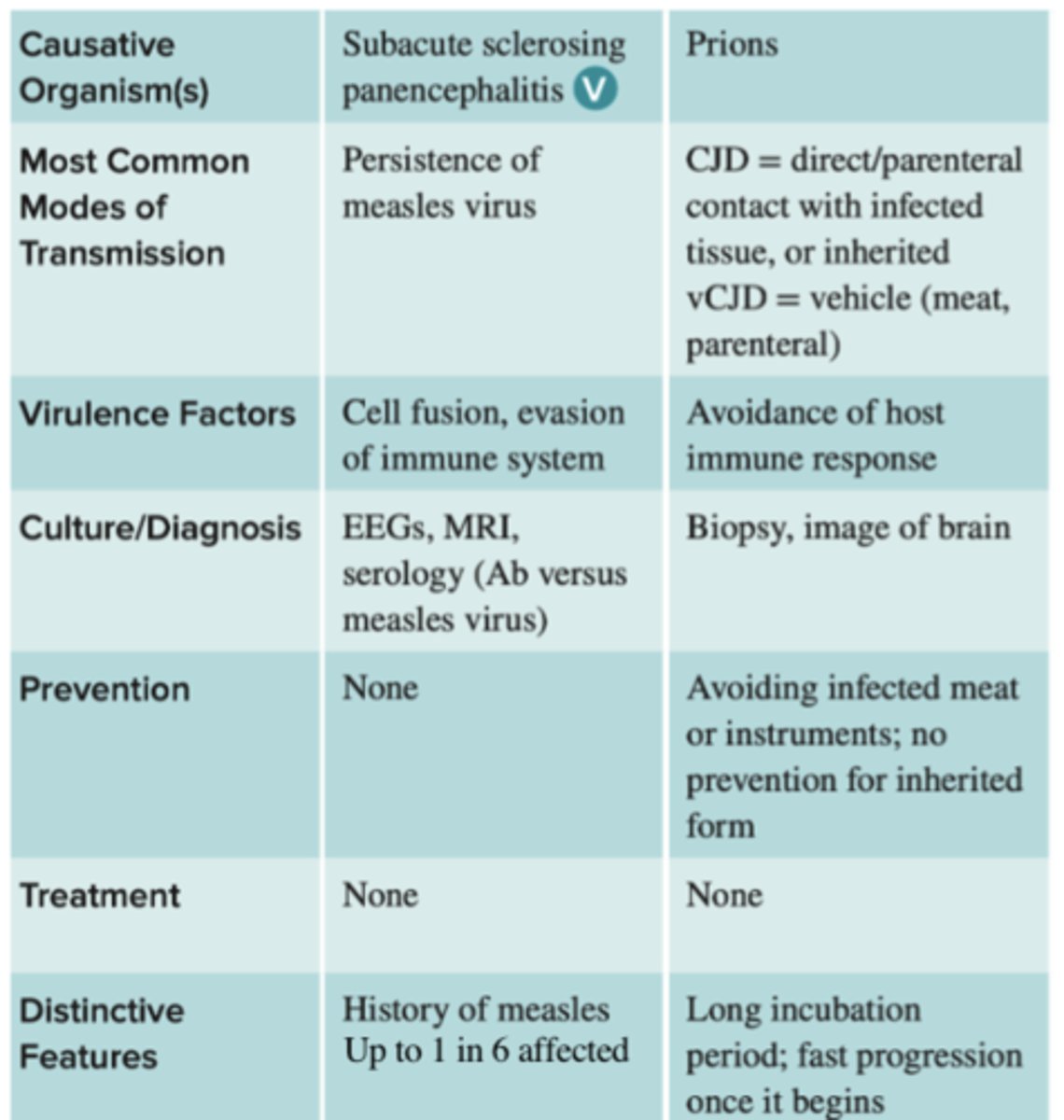
Zyka Virus Disease
•Caused by the Zika Virus
•In adults, range of symptoms: none to skin rash, conjunctivitis, and muscle and joint pain. Can trigger Guillain-Barré syndrome (immune system attacks peripheral nerves)
•During gestation: Can cause congenital Zika virus syndrome. Characteristically small head, not always present. Additional symptoms: vision problems, involuntary movements, seizures, and irritability. Symptoms of brainstem dysfunction such as swallowing problems also common
zyka virus disease chart
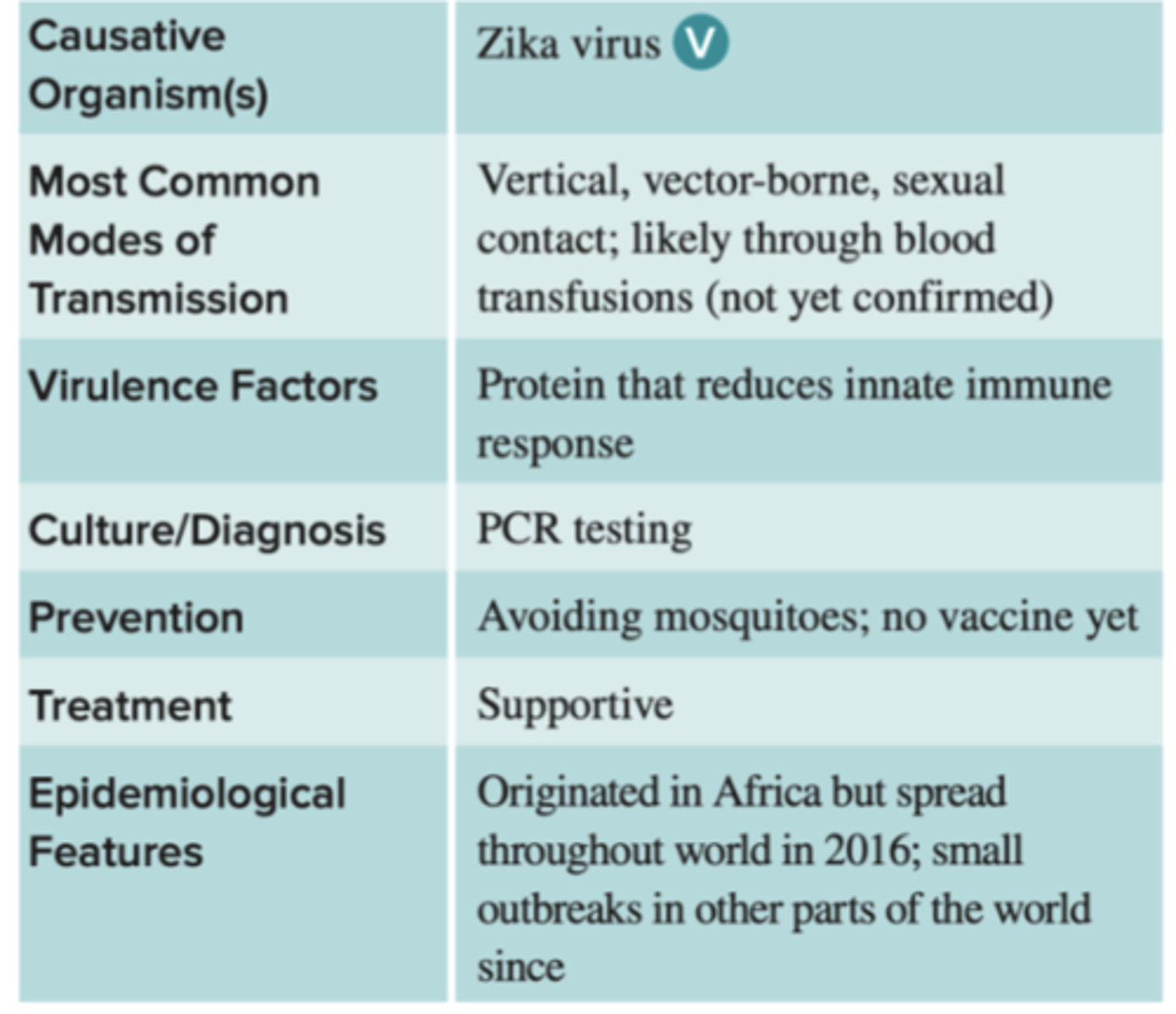
Rabies
•Zoonosis characterized by fatal encephalitis
•Caused by the rabies virus (Rhabdoviridae)
•Reservoirs: wild mammals that can spread the infection to domestic dogs and cats
rabies progress, signs, and symptoms
•Progress, signs and symptoms:
•Incubation over 1 month
•Prodrome with fever, nausea, vomiting, headache and fatigue
•"Furious" form: periods of agitation, disorientation, seizures, spasms in the neck muscles, hydrophobia
•"Dumb" form: paralysis, disorientation, confusion
•Both forms progress to the coma phase, resulting in death from cardiac or respiratory arrest
Rabies graph
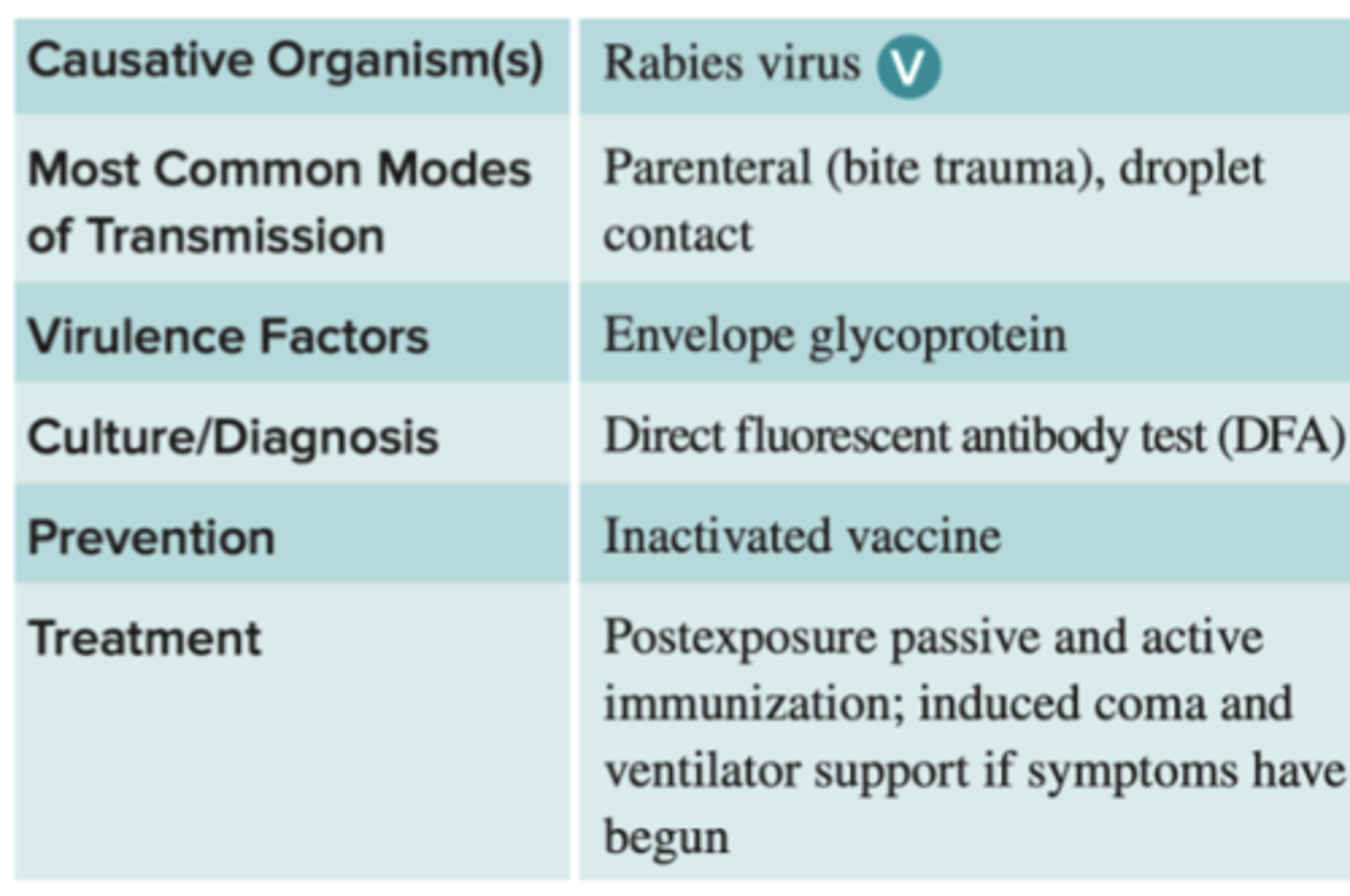
Poliomyelitis (polio)
•Acute enteroviral infection of the spinal cord causing neuromuscular paralysis
•Caused by poliovirus
Poliomyelitis (polio) transmission
•Fecal-oral transmission, through food, water, hands, objects contaminated with feces, and mechanical vectors
•Virus reaches the CNS by way of the tonsils and lymph nodes
•Most infections are contained as short-term, mild viremia
Polio Nonparalytic disease:
invasion but not the destruction of nervous tissue. Muscle pain and spasm, meningeal inflammation, hypersensitivity.
Polio Paralytic disease:
invasion of motor neurons causes flaccid paralysis, leading to muscle atrophy. Sensation is not impaired and crippled limbs may be painful
Polio graph
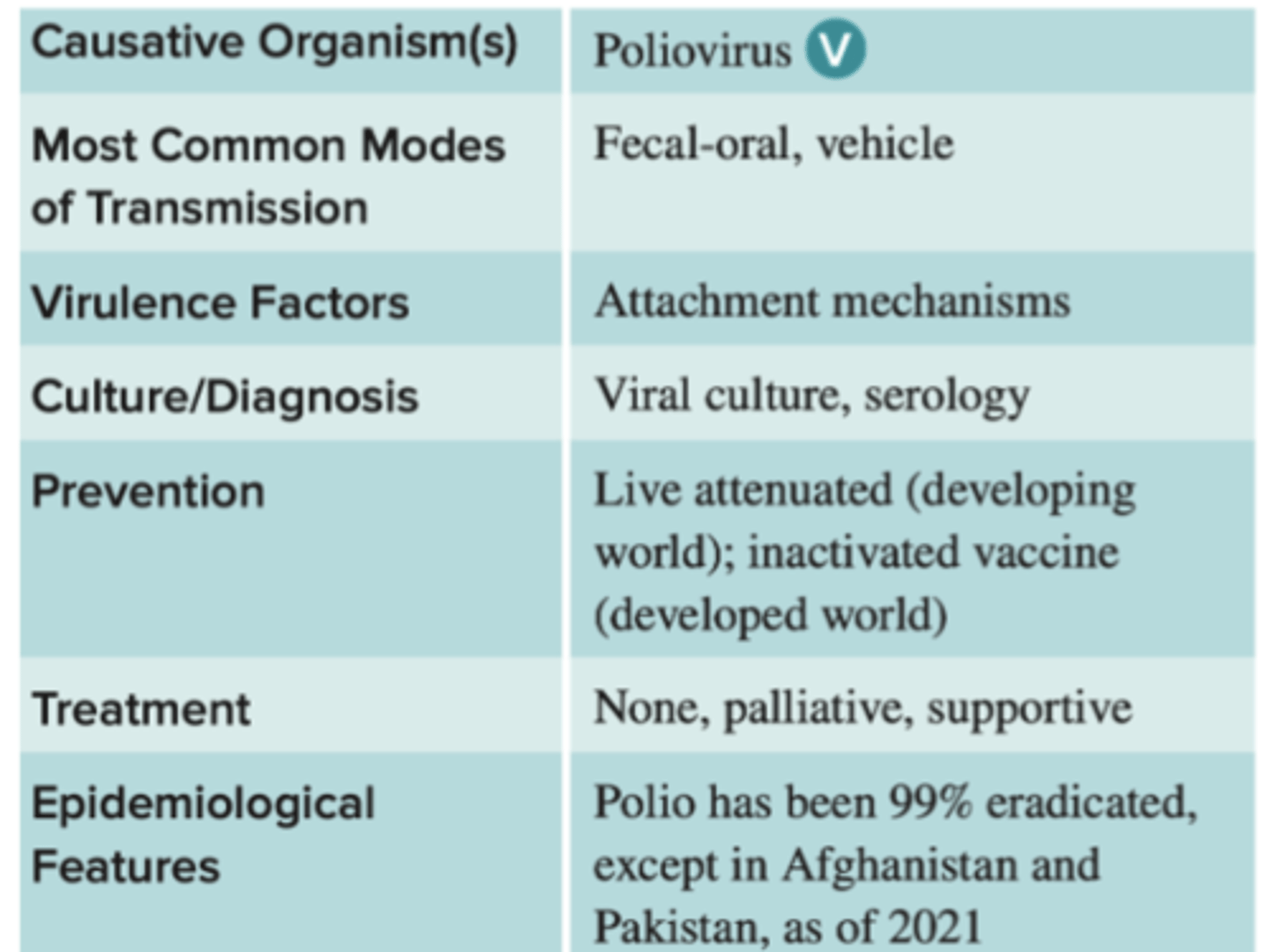
Tetanus
Neuromuscular disease leading to spastic paralysis
Tetanus cause
anaerobic Gram-positive spore-forming toxigenic bacterium Clostridium tetani
Tetanus entry
Spore entry through deep skin wounds
•Tetanospasmin toxin is absorbed by nerve terminals and inactivates inhibitory neurons, causing spasmodic contractions, leading to death by respiratory arrest
tetanus chart
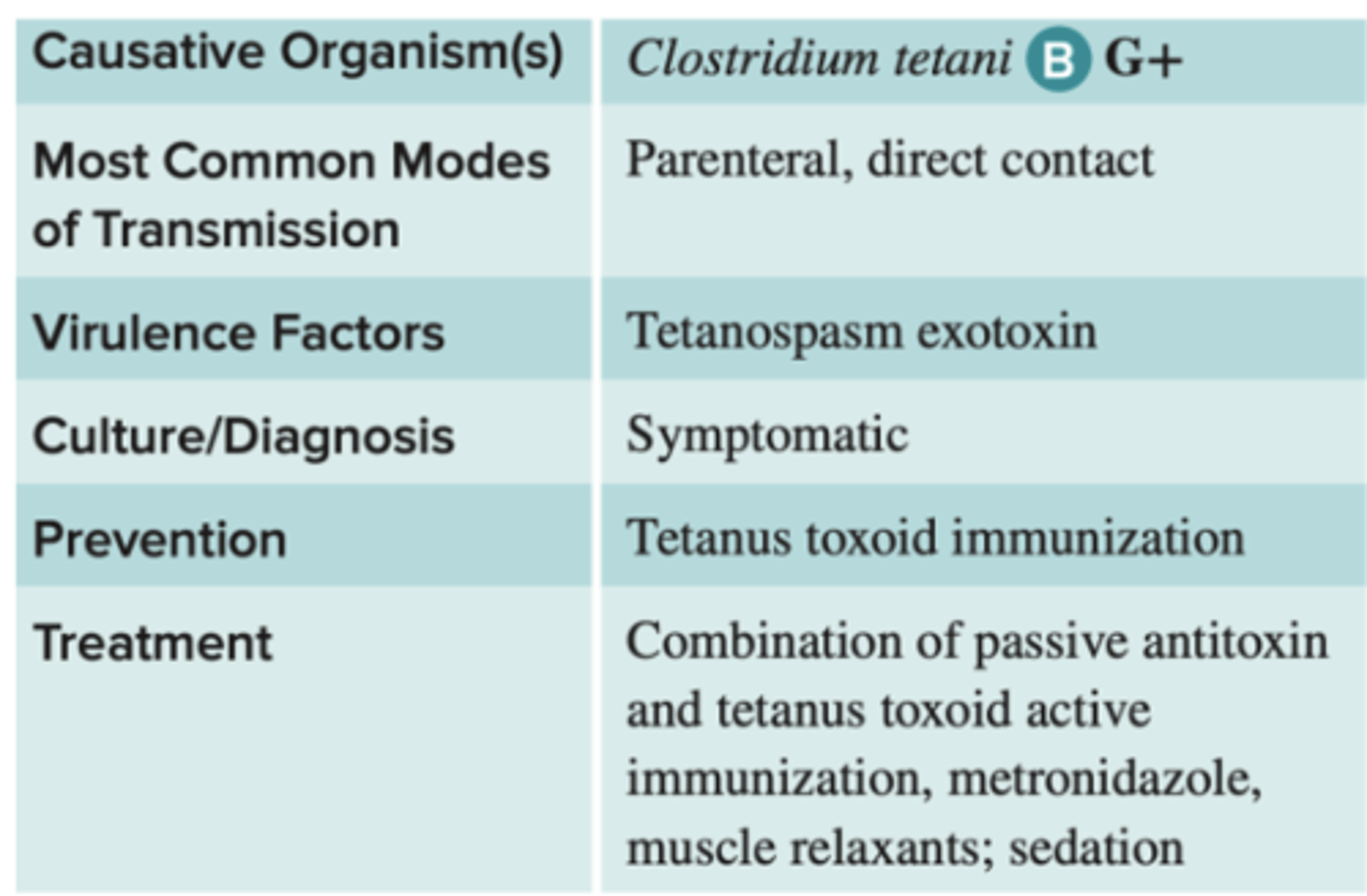
Botulism
Neuromuscular disease leading to flaccid paralysis
Botulism intoxication by
ingestion of botulinum exotoxin, or infection caused by anaerobic Gram-positive spore-forming toxigenic bacterium Clostridium botulinum
Botulism transmitted by
eating poorly preserved food containing even minute amounts of toxin. Rarely by spores ingestion or contact
Botulinum toxin travels from blood to
neuromuscular junctions of skeletal muscles and prevents the release of acetylcholine, that initiates muscle contraction
Botulism signs and symptoms
double vision, difficulty in swallowing, and dizziness, leading to descending muscular paralysis and respiratory compromise
Botulism chart

African sleeping sickness
Neurological disease, endemic in Africa
African sleeping sickness cause
the parasitic protozoan Trypanosoma brucei
• Transmitted by insect (tse-tse fly) bytes
african sleeping sickness signs and symptoms
Trypanosoma persists in the bloodstream by constantly changing its surface antigens (antigenic shift)
• Long incubation period. Intermittent fever, enlarged spleen, swollen lymph nodes, and joint pain, leading to personality and behavioral changes, sleep disturbances, and fatal neurological damage19
african sleeping sickness chart

African sleeping disease image
